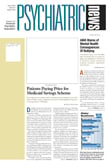At the June meeting of the American Medical Association’s (AMA) policy-making body, the House of Delegates, an unprecedented report was approved recognizing bullying as “a complex and abusive behavior with potentially serious social and mental health consequences for children and adolescents.”
The report, presented to the House by the AMA’s Council on Scientific Affairs (CSA), is in response to a request by the American Academy of Child and Adolescent Psychiatry (AACAP) and the American College of Preventive Medicine, along with the support and endorsement of APA and the AMA Section Council on Psychiatry, that the AMA study the troubling subject.
Carolyn Robinowitz, M.D., a former APA deputy medical director, is a member of the CSA and cowrote the report on bullying, along with CSA member Mary Anne McCaffree, M.D., a pediatrician from Oklahoma. AMA staff member James Lyznicki, M.S., M.P.H., assisted the council members in preparing the report.
Implications
“There were several implications for physicians that were important to have in the report,” Robinowitz told Psychiatric News. “First of all, bullying is a sign of potential psychiatric illness, in both the bully and the victim. We know from our literature review that bullies have a significant incidence of physical and emotional abuse in their past and that they have a higher incidence of adjustment and conduct disorders, and bullying could be a sign of more severe disorders as well.
“Second, we know that bullies are more likely to have long-lasting psychiatric consequences” from their bullying behavior.
Robinowitz added that victims often develop anxiety and depressive disorders as a result of traumatization. “But it is important to note that bullying may not be the standard physical form that everyone thinks of; it is often combined with psychological bullying and can be harder to detect if it is occurring only on the psychological level,” she explained.
Another significant implication for physicians, she noted, is that teachers, caregivers, and often parents are slow to pick up on signs and symptoms of bullying, relying somewhat on the old thinking that “kids will be kids,” often with disastrous outcomes. That makes the issue all the more important for physicians to be aware of, so they can identify signs and symptoms early on and try to prevent further damage from occurring, Robinowitz said.
“I am pleased that the problem of bullying is finally receiving increased attention,” APA Trustee-at-Large David Fassler, M.D., told Psychiatric News. Fassler, the AACAP delegate to the AMA, was one of the authors of the original resolution asking the AMA to conduct the study.
“As psychiatrists,” Fassler continued, “we treat both children and adults whose lives have been devastated by the trauma of bullying.”
The full report, which was adopted by the House of Delegates without amendment, concludes that the complex behavior of bullying involves a pattern of repeated aggression with a deliberate intent to harm or disturb a victim despite apparent victim distress, and a real or perceived imbalance of power allowing the more powerful child (or group of children) to attack a physically or psychologically vulnerable victim.
Recommendations
“Efforts to prevent or reduce bullying,” the report states, “require involved and motivated parents, school administrators, teachers, and other adults with a positive interest in addressing the problem.”
Firm and clear limits for unacceptable behavior, elimination of risk factors promoting bullying, and clearly defined consequences for bullies are also absolutes, according to the report. The report then outlines a series of six recommendations for physicians and the AMA to help combat bullying (
see box above.)
“While we know there are no simple solutions, the report highlights promising intervention and prevention initiatives,” Fassler noted. “The conclusions and recommendations will also enhance public awareness of the issue and help encourage ongoing research into the causes and consequences of bullying.”
The report on bullying is awaiting publication in the Journal of the American Medical Association, after which the complete text will be available on the AMA’s Web site. A summary of the conclusions and recommendations is posted at www.ama-assn.org/ama/pub/article/2036-6398.html. ▪

